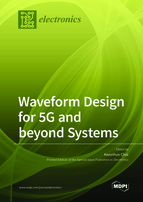Waveform Design for 5G and beyond Systems
A special issue of Electronics (ISSN 2079-9292). This special issue belongs to the section "Microwave and Wireless Communications".
Deadline for manuscript submissions: closed (30 June 2021) | Viewed by 17633
Special Issue Editor
Interests: waveform design; modulation and coding; multiple access techniques; diversity techniques; in-band full duplex radio; multicarrier transmission algorithms
Special Issue Information
Dear Colleagues,
5G traffic has very diverse requirements with respect to data rate, delay, and reliability. The concept of using multiple OFDM numerologies adopted in 5G NR standard will likely meet these multiple requirements to some extent. However, the traffic is radically accruing more different characteristics and requirements when compared with the initial stage of 5G, which focused mainly on high-speed multimedia data application. For instance, applications such as vehicular communications and robotics control require highly reliable and ultra-low delay. In addition, various emerging M2M applications have sparse traffic with a small amount of data to be delivered. The state-of-the-art OFDM technique has some limitations when addressing the aforementioned requirements at the same time. Meanwhile, numerous waveform alternatives, such as FBMC, GFDM, and UFMC, have been explored. They also have their own pros and cons due to their intrinsic waveform properties. Hence, it is very timely to come up with modification/variations/combinations to the aforementioned techniques or a new waveform design for 5G systems and beyond. The aim of this Special Issue is to provide the latest research and advances in the field of waveform design for 5G systems and beyond.
All papers will be peer-reviewed as soon as submitted. The editorial decision will be made about 35 days after submission, on average. The accepted papers will be published continuously in this Special Issue as soon as accepted, irrespective of the submission deadline, and will be listed together on the Special Issue website.
Prof. Dr. Kwonhue Choi
Guest Editor
Manuscript Submission Information
Manuscripts should be submitted online at www.mdpi.com by registering and logging in to this website. Once you are registered, click here to go to the submission form. Manuscripts can be submitted until the deadline. All submissions that pass pre-check are peer-reviewed. Accepted papers will be published continuously in the journal (as soon as accepted) and will be listed together on the special issue website. Research articles, review articles as well as short communications are invited. For planned papers, a title and short abstract (about 100 words) can be sent to the Editorial Office for announcement on this website.
Submitted manuscripts should not have been published previously, nor be under consideration for publication elsewhere (except conference proceedings papers). All manuscripts are thoroughly refereed through a single-blind peer-review process. A guide for authors and other relevant information for submission of manuscripts is available on the Instructions for Authors page. Electronics is an international peer-reviewed open access semimonthly journal published by MDPI.
Please visit the Instructions for Authors page before submitting a manuscript. The Article Processing Charge (APC) for publication in this open access journal is 2400 CHF (Swiss Francs). Submitted papers should be well formatted and use good English. Authors may use MDPI's English editing service prior to publication or during author revisions.
Keywords
- Waveform design for vehicular, device-to-device (D2D), and machine-to-machine (M2M) communications
- Machine learning-based waveform design
- Low latency and low complexity waveforms
- Energy and spectral efficient waveforms
- Synchronization error-resilient waveform design
- Hardware impairments-resilient waveform design
- Hardware implementations of beyond 5G waveforms
- Field testing of the waveforms for 5G and beyond in real wireless channels
- Waveform design for massive multiple access
- Waveform design for multiple-input multiple-output (MIMO) systems
- Waveform design for cognitive radios
- Non-orthogonal waveform design
- Joint coding and modulation for 5G and beyond
- Waveform design for physical layer security
- Index modulation-based waveforms
- Millimeter-wave waveform design






